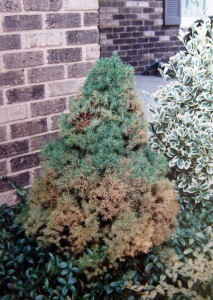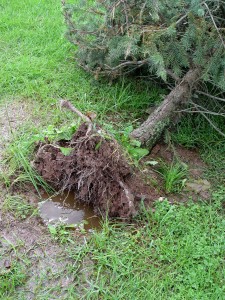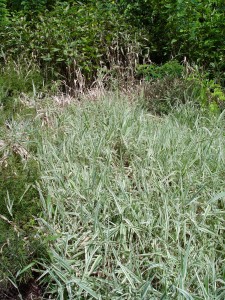Things I Wish Somebody Would’ve Told Me, Part 2
February 16th, 2013
Last week we looked at 10 top bits of yard advice I wish somebody would’ve told me before I started down the trial-and-error path 30 years ago.
Here are 10 more that might save you some grief…
11.) “Some plants are just way better and way less trouble than others.” All plants are not created equal. Some are naturally more prone to bugs, diseases and other mayhem than others. There are lots of great, low-care, low-trouble choices. It just takes some homework to know what they are.
Two sources: the Plant Pick of the Week profiles that post each week on Pennlive.com during the growing season (280 of them archived on my Plant Profiles page) and an 18-page “George’s Survivor Plants for Central Pennsylvania” manual that details the local cream of the crop based on my 30 years of trial and error ($5.95 download ).
Also visit public gardens and quality garden centers to get familiar with good plants.
12.) “Just because you see pros packing mulch up onto the trunk of trees doesn’t mean it’s right.” This has the same effect as planting too deeply in the first place — it rots bark and suffocates roots.
Keep mulch a few inches away from the trunk. Three to four inches is plenty over the rest of the bed under the tree’s canopy.
13.) “Plants can die from not enough water.” Also, “Plants can die from too much water.” The goal is damp, never soggy.
Your finger is a good gauge. If the soil isn’t damp all around and just under the rootball, it’s time to add water. Needed amounts vary by weather and soil type. The first 6 weeks after planting are most critical.
14.) “Lawns aren’t as low-care as you might think.” Add up all the bug and disease controls, the crabgrass preventers, fertilizers, weed-killers, water, etc. and a big lawn isn’t particularly cheap or low-care.
What other plant do we prune 25 times a season?
Consider converting at least some lawn to truly low-care plantings.
15.) “The truly lowest-care yard is a mix of:” a.) Trees with groundcover; b.) dwarf evergreens, and c.) compact flowering shrubs.
According to “George’s Garden-Work Pyramid,” the highest- to lowest-care plant families are: cutting roses and fruit trees; vegetable gardens; beds of annual flowers; perennial gardens; the lawn (unless you’re a lawn fanatic, in which case it’s No. 2 on the work list); flowers in pots; compact evergreens and shrubs, and least of all, trees with groundcover underneath.
16.) “Just because perennials come back every year doesn’t mean they’re no work.” Yeah, you don’t have to replant them every spring, but perennials don’t bloom as long as annuals, and most of them require annual cutbacks, some in-season primping and occasional division, fertilizer and water.
17.) “You can’t prune whatever you want whenever you feel like it.” You may not kill your plants outright with ill-timed pruning, but there’s a good chance you’ll get few or no flowers the following season because you cut off the flower buds.
Rule of thumb: If it blooms early (i.e. before mid-June), prune it right after it’s done flowering. If it blooms later (i.e. after mid-June), prune it early (going into the season).
Fall is a bad time to prune most any woody plant.
18.) “Beware of friends bearing gift plants.” You may well get a great plant for free, but you also may get someone else’s thug. People are most likely to give away plants that have been getting too frisky in their own yard.
Know what plant you’re being offered, ask just how frisky it’s been, and just say no if you’re in doubt.
Sixteen common pass-alongs that cross my line: ribbongrass, houttuynia, morning glory, hardy ageratum, mint, bamboo, yellow archangel, bishop’s weed, creeping jenny, ivy, Johnny jump-ups, bugleweed (ajuga), bellflowers, bronze fennel, spiderwort and obedient plant.
19.) “If you’re thinking about growing vegetables, get a fence up first.” You can try repellents, traps and hoping for the best, but growing vegetables is like a free dinner invitation to every animal within 10 miles.
The Big Four are rabbits, voles, deer and my arch nemesis, the groundhog.
Some people use electric fences. I have an unsecured 3-foot-high fence with a buried board to prevent tunneling of rabbits and groundhogs (no deer problems).
Also good is a post-and-rail fence with vinyl fencing secured to the inside and a buried board around the perimeter.
For deer, it’ll probably take an 8-foot-tall perimeter fence or two parallel 5-foot fences spaced 4 feet apart.
20.) “Don’t take it all too seriously. Have fun.” Life has enough trouble outside of the cabbage patch.
Gardening should be fun. Don’t sweat it if an azalea dies or a stink bug shows up.
You want a train in the back yard? Do you like the looks of one of those blue bottle trees? Does a polka-dotted frog statue make you smile?
Go for it. It’s your yard.










